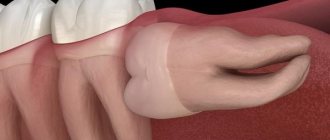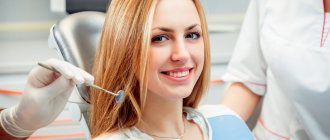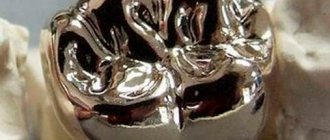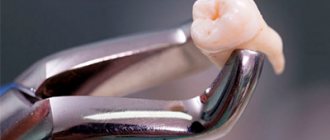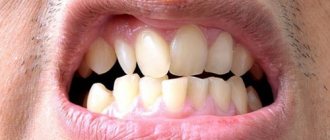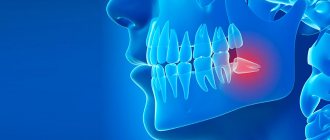How do “eights” erupt?
Wisdom teeth are the last teeth to erupt. Sometimes at 18–20 years old, but more often at a later age. In addition to the fact that these are the largest teeth, there are cases when they are located in the jaw bone not vertically, but at an angle. Therefore, problems most often arise with their eruption: the tooth does not grow upward, but to the side, pressing on the root of the nearest tooth, causing pain and inflammation. Often, to avoid such problems, wisdom teeth are removed without waiting for them to fully erupt.
Wisdom teeth often cause problems when they erupt
But if the tooth grows more or less without problems, the person does not see a dentist; there is no indication for tooth extraction. And then it turns out that due to the growth of molar No. 3, the front teeth have moved.
“Eights” are large teeth, and if there is not enough space in the dentition, they move neighboring teeth, and even the front ones.
Crowded teeth
Is it possible to remove a tooth and return everything as it was?
If you remove a tooth, nothing will change. Orthodontist patients know that after treatment a consolidation stage is needed, otherwise the roots of the teeth will begin to move to their old familiar place. It takes at least two years for the teeth to adjust and strengthen in their new position, and to do this they are held in place with the help of retainers and aligners.
During orthodontic treatment, the pressure from braces or aligners is much greater than that exerted by the growing wisdom tooth. Therefore, with an orthodontic system, teeth are moved within a few months, and the first results are visible within a few weeks.
Aligners correct the position of teeth in a few months
A growing molar erupts very slowly, over 2–3 years, and puts pressure on neighboring teeth, causing them to move. The process occurs almost imperceptibly, the teeth shift by fractions of a millimeter per month. During this time, they get used to the new (wrong) position. The ligamentous apparatus that supports the teeth is rebuilt to a new position, and the bone tissue around the roots is strengthened. And even if wisdom teeth are removed, it will not be orthodontically beneficial. Neither from a health point of view, nor from an aesthetic point of view.
Myths about teeth
Myth 1. Whitening is harmful - it damages the enamel...
No. The color of a tooth is given by dentin - the main tissue of the tooth, which is located under the enamel. To reach the dentin and lighten it, a whitening gel is applied to the teeth and activated by the light of a special lamp, as a result of which the gel breaks down into water and oxygen. Oxygen penetrates dentin and discolors pigments, but does not change the structure of dentin. And calcium phosphate, which is part of whitening systems, helps improve the structure of tooth enamel. The whitening procedure ends with remineralizing therapy, which reliably protects the enamel surface. We use only advanced whitening technologies - the ZOOM2! whitening system; this technique allows you to lighten your teeth by an average of 8 shades (and sometimes 10-12) in just one visit. Remember: whitening is safe if carried out under the supervision of an experienced, certified and experienced doctor, using certified equipment using original whitening gel.
Myth 2. After whitening, cracks will appear on your teeth...
No. During professional whitening, cracks in teeth cannot appear, especially since modern systems for professional in-office whitening Zoom2 contain a special component (amorphous calcium phosphate) that can penetrate the thickness of the enamel and strengthen it.
Myth 3. Teeth can be whitened with baking soda...
Yes, but you can use baking soda no more than once a week, as it can scratch the enamel. Another thing is pastes containing bicarbonate of soda. There, the soda particles are much smaller in size and do not injure the enamel as much. Such pastes can be used daily, but not longer than a month, then you need to take a break.
Myth 4. Be sure to brush your teeth 2 times a day...
Yes. You need to brush your teeth at least 2 times a day, and maybe more. It all depends on how quickly plaque accumulates on the teeth. Ideally, you should brush your teeth after every meal.
Myth 5. In the morning you should brush your teeth after breakfast...
Yes, you need to brush your teeth after eating. But in the morning it is preferable to do this before breakfast (to remove accumulated plaque overnight and for yourself personally - to feel freshness) and always after breakfast - to cleanse the oral cavity of food debris.
Myth 6. Overbite can only be corrected in childhood...
No. You can correct your bite at almost any age. But there is a severe pathology in which changes have occurred not only in the position of the teeth, but also in the jaw bones. In this case, there are certain age limits.
Myth 7. It is necessary to treat a diseased tooth “to the last” before removing it...
Yes. Tooth extraction leads to gradual displacement of adjacent teeth, which affects the appearance and can create serious problems with chewing. Displacement will definitely occur, because each of the teeth in the dental system has its own function and load. Therefore, it is better to treat the tooth “to the last.” But, if removal cannot be avoided, it is better to immediately place an implant.
At the same time, the removal of a wisdom tooth, unlike the removal of other teeth, does not threaten a significant curvature of the bite that occurs when neighboring teeth move to the place of the removed one.
Myth 8. Healthy enamel is white enamel...
No. There are no absolutely white teeth in nature. Their color depends on dentin and is inherited. It is believed that the strongest tooth tissues are those whose color is yellowish.
Myth 9. Caries occurs from sweets...
And not only. Caries appears as a result of the activity of microbes that secrete acids that dissolve the enamel. The more remains of ANY food in your mouth, the more food for germs. We brush our teeth after every meal, but we forget that we need to do the same after eating caramel. But chocolate is even useful, because the substances contained in cocoa beans protect teeth from caries due to their antimicrobial effect. But everything must be done in moderation. Dentists recommend drinking Pepsi and Coca-Cola through a straw, because it reduces the contact of the liquid that spoils the enamel with the front teeth by almost 70%, and with the molars by 30-50%.
Myth 10. Floss and mouthwash are essential for teeth...
Almost right. Balms and rinses are additional hygiene products and are used as desired. They contain substances that prevent bacteria from attaching to the tooth surface. But dental floss is one of the BASIC hygiene products that you must use.
Myth 11. You should use chewing gum after eating...
Can. But no more than 10 minutes. After eating, the acid-base balance in the mouth changes, which contributes to the development of caries. Balance can be restored by chewing gum. But you should not chew it for a long time, since the chewing process stimulates the production of gastric juice. But since it doesn’t arrive, the stomach has to “digest” itself and its mucous membrane suffers.
Myth 12. It is not necessary to treat baby teeth - they will fall out anyway...
Wrong. You should definitely contact a pediatric dentist. Baby teeth fall out as a result of physiological resorption of their roots. Between them all this time there are permanent teeth, which erupt in place of milk teeth. If left untreated, caries of a baby tooth can lead to inflammation, delayed eruption, underdevelopment of enamel, or even complete melting of the permanent tooth germ.
Myth 13. The more expensive the toothpaste, the better it is...
Not necessary. But pastes of unknown origin can “help” you acquire new microbes that are unfamiliar to our defense systems. Therefore, it is better to buy toothpaste in pharmacies.
Myth 14. You should use a different paste in the morning and evening...
Yes. In the morning you need to use highly abrasive pastes, including bleaching ones, and in the evening – pastes containing extracts of medicinal herbs.
Myth 15. You need to change the toothpaste from time to time...
Yes. Oral microbes very quickly get used to the beneficial properties of the paste (especially if the paste contains antiseptics - triclosan, chlorhexidine) and stop reacting to them.
Myth 16. If your teeth don’t hurt, you don’t need to go to the dentist...
No. You need to visit the dentist once a year. Only a dentist can see the initial stage of caries. In addition, you need to regularly remove plaque and dental deposits (tartar). Stones can be hidden under the gum and are more dangerous than supragingival deposits.
Myth 17. Gold never causes allergies...
Wrong. Gold in the mouth can be a strong allergen. Some people experience severe inflammation in areas where gold crowns come into contact with the oral mucosa. So sometimes any ordinary alloy is better than gold.
Myth 18. Implantation is very painful...
No. Modern anesthetics, for example, ultracaine, are 6-8 times stronger in their analgesic effect than novocaine. Almost no clinic in the city no longer works with Novocaine. In the absence of contraindications or at the request of the patient, implantation can be performed under general anesthesia (anesthesia).
Myth 19. Implants do not take root well...
No. Official statistics say that out of 100 installed implants, from 2 to 4 are rejected. this is about 96-98% engraftment. By definition, there cannot be a 100% guarantee. These are not just numbers. They are backed by serious research and global experience.
Myth 20. When the nerve is removed, the tooth will definitely be destroyed...
No. After the “nerve” is removed, the tooth is fed through the suspensory ligament, therefore, the tooth does not become “dead”. And its fragility is explained by the initial tissue defect, which became the reason for the removal of the “nerve” - caries or injury. Therefore, it is important to properly restore a weakened tooth. There are international standards for dental restoration, which we follow in our Clinic: if there is a hard tissue defect of up to 1/3 of the tooth, it is possible to restore the tooth with a filling, up to 1/2 requires a ceramic inlay, and if more than 1/2 of the tooth is damaged, a crown is already necessary.
Myth 21. Wisdom teething always hurts...
Almost true. Indeed, the eruption of wisdom teeth is often accompanied by pain, because:
- the wisdom tooth does not have a milk predecessor that would prepare the conditions for its eruption;
- wisdom teeth erupt when the formation of the jaw bone tissue is completely completed, and they have to overcome significant mechanical obstacles;
- the tooth does not have enough space in the dentition, which is associated with changes in the masticatory apparatus in the process of human evolution.
What to do?
Treatment with braces or aligners will help correct the position of your teeth. However, it is not necessary to remove grown wisdom teeth. Whether to save them or not is decided individually in each case and only after examination. If it is possible to expand a row of teeth so that there is enough space for all teeth, then there may be no indication for removal. It is always better to preserve healthy teeth, this also applies to third molars.
If the teeth were initially straight and the erupting wisdom tooth has distorted them, a slight disturbance in the position of the teeth usually occurs. Regardless of the patient’s age, it can be corrected in a few months.
What is Popov-Godon syndrome?
About a third of people, if one tooth is removed, do not even think about restoring it. Some motivate this by the fact that if they lose their back teeth, “you still can’t see anything”, the process of chewing food is still not disturbed, others are afraid of “spoiling and grinding down” the neighboring teeth during prosthetics, etc.
Indeed, with the loss of one tooth, disturbances in the mechanical processing of food, as a rule, do not occur. If not for one “but”. The fact is that in the absence of a single tooth, quite often a compensatory reaction of the body occurs in the form of the formation of a defect in the dental arch, which causes deformation of the occlusal curve. Simply put, neighboring teeth shift into the space vacated by the lost tooth. In this case, gaps appear between the displaced teeth, sometimes quite significant. However, not only those teeth that are located next to the missing one in one row are deformed, but also the antagonist teeth (located on the opposite jaw): dentoalveolar elongation , or the Popov-Godon phenomenon. The tooth that is located opposite the removed one protrudes from the dental arch and creates a kind of “occlusal lock”, which complicates the movement of the jaws, increases the chewing load, resulting in malocclusion.
Reasons for tooth displacement after tooth extraction
Displacement of teeth can occur in various directions; simultaneously with displacement, an increase in the alveolar process, the formation of a gum pocket and exposure of the tooth root can be observed. The Popov-Godon phenomenon occurs due to changes in the structure of the periodontium due to the loss of the usual functional load (adaptive restructuring), in which there is a disruption of metabolic processes and microcirculation in the periodontium, an increase in the size of the alveolar process and the volume of bone tissue. At the beginning of the process of adaptive restructuring of the periodontium, an increase in the volume of tissues formed occurs, while the tooth moves beyond the occlusal plane, and in a later period the atrophic process with the phenomena of periodontal resorption (“atrophy from inactivity”) predominates.
Specialists in the field of periodontology are well acquainted with the Popov-Godon , since it can develop at any age, but if in adults this process develops gradually, then in childhood and adolescence it develops much faster. In some cases, teeth that do not have antagonists on the opposite jaw can reach its mucous membrane.
Methods for increasing the space between teeth
There are several ways to expand the space between the units adjacent to the defect. These include:
- Orthodontic correction. This is the most effective and expedient method. A brace system is installed to move the teeth towards their original locations. This treatment lasts about 1–1.5 years, but there is a point in waiting that long. With the help of orthodontic treatment, it is possible to straighten the rows, restore the normal angles of the teeth and free up enough space for the implant.
- Orthopedic manipulations. You can also get more space between the teeth adjacent to the empty area by “filing” their lateral surfaces. But it is advisable to resort to such a solution only if there is a slight shortage of space for installing the prosthesis.
- Surgical intervention. Another way to expand the space for an implant is to remove an adjacent tooth. Such a radical approach can only be considered if the unit is severely damaged. An indication for extraction may also be a severe tilt of the tooth with exposure of its neck and the appearance of mobility.
The dentist chooses the method of expanding the space for the implant after diagnosing the problem area. As a rule, the problem is solved by installing braces, and then a new beautiful tooth on an implant can be easily installed in the vacant space.
Memo to the patient: how to prevent relapse
You should take care of the lasting result of the correction even before it begins, by responsibly approaching the choice of the attending physician.
- Based on the results of the diagnosis, a good orthodontist must definitely explain why the anomaly occurred and how to get rid of it. If you do not understand the source of the problem, make an appointment with another specialist. Trust is an important factor, without which it will be difficult for you to go through a difficult path together.
- Be a motivated patient. The question “Which braces are better, sapphire or ceramic?” Decide only together with your doctor and follow his recommendations at each stage. You work in tandem, and when planning treatment, he counted on your conscientiousness.
- Remember that the key to lasting results is not only the beauty of the smile, but also the functionality of the formed bite. When it seems to you that your teeth are already straight, do not insist on removing braces. You need to strive to achieve an ideal orthognathic bite, and only an orthodontist can record the moment of maximum approximation to the ideal.
And finally, the main rule: orthodontic treatment does not end with the removal of the system. We can say that once you wear braces, they will stay with you forever. To avoid relapse, you will have to wear a retainer, since due to shape memory, the bone tissue will strive to return to its previous position over many years. It can only be removed with the doctor's permission.
Simple wisdom tooth removal method
For a simple operation, the surgeon uses forceps and an elevator without resorting to incisions or drilling into the bone. This method allows you to extract a molar if:
- the upper wisdom tooth needs to be removed;
- there are no significant developmental deviations;
- there are no complicating circumstances.
Wisdom tooth removal proceeds as follows:
- 1. The dentist collects anamnesis, inquires about the patient’s allergic reactions to medications, and selects the optimal anesthesia;
- 2. an anesthetic drug is administered, its effect begins after about 5 minutes;
- 3. the surgeon prepares instruments, the sets of which differ depending on the location of the tooth, its condition, and the presence of inflammation;
- 4. Using forceps or using an elevator, the tooth is removed from the socket;
- 5. The doctor treats a fresh wound with antiseptic drugs;
- 6. If necessary, an anti-inflammatory agent is placed in the hole.
After the removal of wisdom teeth, large sockets remain, so the surgeon sutures the tissue to prevent infection and speed up healing. In the presence of purulent processes and inflammation, suturing the hole is not advisable, since the contents must have an unimpeded outflow. The manipulation usually takes no more than 10 minutes. To monitor the patient’s condition, the doctor schedules an examination a few days after the operation to remove the diseased wisdom tooth.
Indications for wisdom tooth removal
Treating third molars is a challenging task, but a competent dentist will try to keep the unit relatively healthy. However, in practice, even relatively healthy “eights” are extremely rare.
Most often, problems begin at the teething stage, which is associated with pain, fever, swelling and other troubles. The doctor prescribes wisdom tooth removal if:
- an unerupted molar is incorrectly positioned in the jaw, injuring neighboring teeth and soft tissues;
- extensive caries damage with significant destruction of the crown;
- pericoronitis (presence of an inflamed hood);
- installation of a bracket system. Sometimes only the removal of a wisdom tooth can ensure the correct movement of other molars;
- presence of a cyst;
- the trigeminal nerve is pinched;
- pulpitis, periodontitis.
Most experts are inclined to believe that the “eight” should be under the supervision of a doctor from the moment of eruption. An x-ray is sufficient to assess the development of the tooth and assess future prospects. This needs to be done immediately, if only because for young people the rehabilitation period is much easier and the likelihood of complications is minimal.
